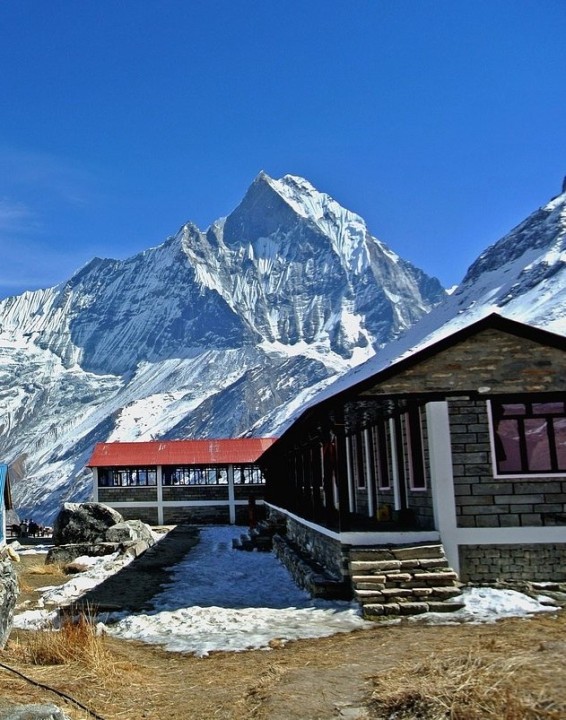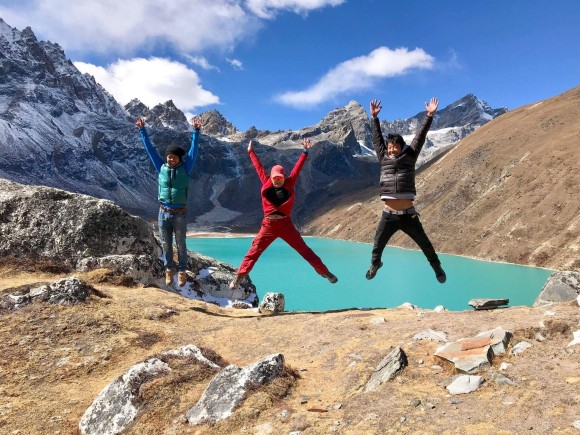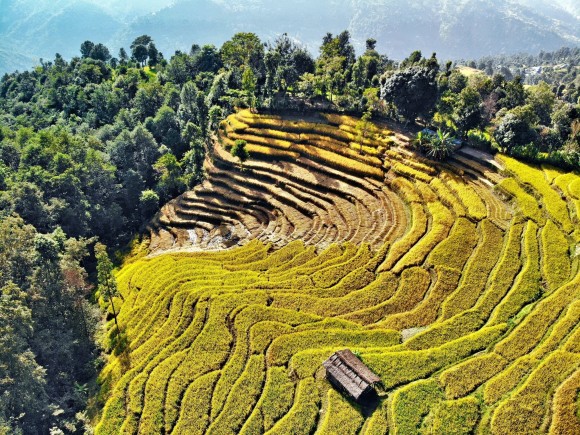Climbing Lobuche Peak is a thrilling adventure in the Khumbu Region of Nepal. The Lobuche East Peak is 6,119m high, and the Lobuche West Peak is 6,145m. This beautiful climbing trip is great for climbers of all skill levels, from beginners to experts. We will climb the beautiful East Peak of Lobuche, which is a bit easier than the West Peak. We can see great views of snow-covered mountains like Mt. Everest (8,848 m), Mt. Cho Oyu (8,201 m), and Mt. Lhotse (8,516 m), Mt. Nuptse (7,855 m), and others. Trekkers from all over the world go there because it has amazing views of the Himalayas as a whole.
Also, the trek goes along the trail to Everest Base Camp. It starts with an exciting flight to Lukla. Along the trail, we can see the rich plants and animals of the area and beautiful Sherpa villages. People's unique customs, traditions, and ways of life, as well as their tasty food, will enchant you. On the way to Lobuche Base Camp, the trek goes through the Everest Base Camp. Also, this plan for climbing Lobuche Peak is well thought out and includes regular acclimatization to help you get used to the area. This trip will be remembered for the breathtaking beauty of the Mahalangur Himalayan Range and the lush green trails. Aside from that, the Sherpas will make you fall in love with the place because of how friendly they are. We're charging a fair price for this wonderful peak climbing package. Read on for a more detailed description of how to climb Lobuche Peak and other information.
Highlights
- Going up the beautiful Lobuche Peak (6,119 m)
- Experience real Sherpa culture in one of the world's highest settlements. Learn about the culture, traditions, and way of life in local Sherpa villages.
- Crossing Kongma La Pass (5535m) along a challenging trail
- Beautiful views of the Himalayan sunrise over the Everest region's snow-covered mountains.
- From the top of Lobuche Peak, you can see beautiful views of Mt. Everest, Mt. Amadablam, Mt. Nuptse, Mt. Lhotse, and many other snow-capped peaks.
- People in the teahouses were very friendly and helpful.
- Mountain guides who are experts and experienced climbers
- Trying the tasty food of the area
The hiking trail
The plan to climb the Lobuche peak starts with a short 30-minute flight from Kathmandu to Lukla. Trekkers will go through green hilly landscapes, steep terrains, and the foothills of snow-covered mountains. The steep descent takes you to a small airport in Lukla, where you will meet the rest of our team and eat lunch.
The next day, we start walking to Phakding and Namche Bazaar. To get to Namche Bazaar, the commercial center of the area, we walk through lush vegetation and look at the mountains around us. We walk from Namche to Tengboche to look at the old Tengboche monastery.
Also, the beautiful monastery has a rich religious and cultural history. The trail then goes to Dingboche, where we stay for a few days to get used to the altitude so we don't get altitude sickness. From there, we hike to Lobuche via the Kongma La Pass (5536m). The trail has a lot of steep climbs and drops. We travel from Lobuche to Gorak Shep and then to the beautiful Everest Base camp, where you can see the mighty Mt. Everest.
Also, the path goes back down to Gorak Shep and then leads to Lobuche Base Camp. We spend a day getting used to the altitude and then climb the Lobuche peak early the next morning. After exploring the top of the mountain for a while, we go back down to the base camp. Then we go to Namche, and from Lukla, we take a flight back to Kathmandu.
When is the best time of year to climb Lobuche Peak?
- Climbing Lobuche Peak is only possible when the weather is good. Whether that is hard to predict and strong winds can make it harder to get to the top of a mountain. The best times to climb Lobuche Peak are during the fall, from September to November, and spring, from March to May.
- Autumn has clear skies and moderate temperatures in the lowlands and colder temperatures in the highlands. Autumn has a lot of holidays, such as Dashain, Tihar, and others. So, you also have a chance to learn about the culture of the area. Temperatures can drop around -5 degrees celsius in autumn. But you don't have to worry if you have warm gear and clothes with you.
- Another great time to go peak climbing in Nepal is in the spring. You will walk through the rough terrain of the area. You can also see the pretty Rhododendron bushes that cover the hills and turn them pink and red. Trekkers can see the region's beautiful scenery in all of its glory. During spring, it can get down to about -2 degrees Celsius.
- Also, snow, freezing temperatures, and slippery trails are common in the area during the winter. During the rainy season, there are wild leeches, and during the winter, there are thick layers of snow on Lobuche Peak. So, these times of year are not good for climbing peaks in Nepal. So, the best times to climb peaks in Nepal are in the fall and spring.
How hard is it to climb the Lobuche Peak?
- In the Everest region, Lobuche is one of the more technically difficult peaks. To climb Lobuche East Peak, you have to walk for 5–6 hours, and on the day of the summit, you have to climb for 8–10 hours. From Lobuche village to Lobuche Base Camp, the path up is steep, rocky, and tiring. Trekkers need to have a lot of stamina and endurance to walk through the rocky and rough terrain of the area.
- Also, there is a lot of fatigue and altitude sickness in the area because of its high altitude and thin air. Trekkers have to go over slippery ice or snow-covered rocks. These stones are too steep and dangerous to walk on. Before you get to the summit ridge, you have to climb up a 45-degree snow wall. This makes the climb very hard. It is dangerous to use fixed lines to climb up 50 m through the wall.
- Climbers must also learn how to use ropes, crampons, and cables as they go along the trail. The icy and snowy stones on the trail make it more dangerous for beginners. Even the most experienced trekkers can get sick from the high altitude. We have a specific plan with enough time for acclimatization to deal with AMS (Altitude Mountain Sickness).
- Lobuche peak can be tried by climbers of all skill levels, from beginners to experts. For people who have never climbed a peak before, it can be hard, but if you are well-prepared and really want to, you can reach the top of the Lobuche peak. With the right packing, planning, preparation, gear, and guidance, this beautiful climb is easy to finish.
How fit do I have to be to climb Lobuche Peak?
- Lobuche peak climbing doesn't require you to have climbed before, but you do need to know how to use basic mountaineering gear like crampons, a harness, ice axes, carabiners, and other tools. For the climb and trekking adventure, you need to be at least a little bit fit.
- Before the trek starts, you need to do some short training. Physical stamina is important, so you should do things like go for bike rides or short hikes to build muscle strength and endurance. Before the trek, you should talk to your doctor if you take regular medications or have a lung-related illness.
How to Train for Climbing Lobuche Peak
Before the trip, trekkers and climbers need to do some basic training so they can reach the top of the mountain. These training plans should help build mental and physical strength. At least two to three months before the trek, you should start this training.
Workouts for the body
- Trekkers and climbers have a lot of endurance, strength, and stamina because they train their bodies. It will also help the trekkers get in better shape. On the trek, you'll walk for about 5–6 hours, so train for that.
- These exercises also help you get stronger in your arms, shoulders, and back. A diet high in carbs and protein will help you a lot to get the physical strength you need for peak climbing.
Cardiovascular exercises
Cardiovascular exercises like running, cycling, paddling, jogging, and hiking will help you get more oxygen, which will make altitude sickness less likely. Also, these aerobic exercises help prevent injuries, make you more flexible, and ease muscle strain.
Mental preparation
Preparing your mind will help you keep your mind stable on the trail. Having a good attitude is important on this hard trek through the area. You should go on one-day practice treks to get a general idea of what the trek will be like.
Aside from that, experienced trekkers can also tell you important things about climbing Lobuche Peak in Nepal. Preparing your mind also helps keep you going on the trail.
Food and places to sleep along the way
Trekkers will stay in the tea houses along the trail that are run by the community. These places to stay offer both food and a place to sleep. The trail to climb Lobuche Peak is the same as the trail to Everest Base Camp.
Also, the tea house rooms have two twin beds, a pillow, a blanket, and a mattress. People who go hiking should bring their toiletries with them. You can pay extra for things like hot water, electronic charging, and other amenities.
Dal Bhat is a common dish along the trail. It has rice, dal (pulses), spinach, lentils, vegetables, pickles, gundruk, and meat. It is served at both lunch and dinner in the tea houses. There are also other Chinese and international dishes like momo, chowmein, pasta, porridge, noodles, sandwich, burgers, eggs, bread, and more.
Aside from that, you can also get tea, coffee, garlic soup, lemon tea, rhododendron tea, mint tea, and other hot drinks. During the trek, you can also eat protein bars, granola bars, chocolate bars, and Snickers. But you shouldn't drink alcohol on the trek because it can make you sick from the high altitude.



 Travel Gear List
Travel Gear List















.jpeg?path=trips/June2021&w=1323&h=1420)

.jpeg?path=trips/May2022&w=1323&h=1420)






